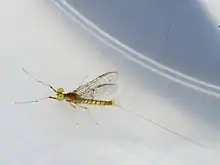Stenacron
Stenacron is a genus of mayflies in the family Heptageniidae.
| Stenacron | |
|---|---|
_(14911907812).jpg.webp) | |
| Stenacron interpunctatum | |
| Scientific classification | |
| Kingdom: | Animalia |
| Phylum: | Arthropoda |
| Class: | Insecta |
| Order: | Ephemeroptera |
| Family: | Heptageniidae |
| Genus: | Stenacron Jensen, 1974 |

The genus of Stenacron (Jensen 1974) is a vastly understudied and largely misunderstood genus. From P A Lewis (1974) "The Taxonomy and Ecology of Stenonema Mayflies" forward, very little to nothing has been done with this genus in the field and in laboratories.
Stenacron ecology
Although the larva can be found in many different conditions they have some basic and preferred requirements. All samples I have collected regardless of the form or species are found near the bank. They tend to cling to the underside of rocks that are a minimum of 8 X 8 inches and 2 inches thick. The larger the rock the greater the population per rock. They are seldom found in the faster riffle waters but more so at the slower moving banks. Typically with a water depth of no less than 3 inches and up to 16 inches deep. The most important factor is the waters "DO" (dissolved oxygen). Stenacron can live in waters that are not moving and low in (DO). In rearing experiments I have found that they can survive and hatch in a bucket with little oxygen added for up to 4 days. However, in a watershed they do prefer a stable and moderate DO in which greater populations will occur. Lewis (1974) showed that the form (Stenacron interpunctatum / heterotarsale) historically carried an EBI (Empirical Biotic Index) rating of a level (7) showing a high tolerance level to pollution's both Toxic and Organic. (under updates)
Brief history
Dr J R Traver, the second author of the Biology of a Mayfly (1935), erected three distinct groups in the genus Stenonema in 1933. The interpunctatum group later became the genus Stenacron. Steven L Jensen in 1974 erected the genus name Stenacron.
There are currently 16 forms that reside in this genus and only 7 of the forms carry a valid species status. The other remaining forms have all been synonymized into the valid species Stenacron interpunctatum. These forms are referred to as Stenacron interpunctatum / interpunctatum not as Stenacron interpunctatum.(Say 1839)
Thomas Say, the god father of American entomology, first documented the species interpunctatum in 1839 in Indiana from 20 halotypes and 14 paratypes. Hagan (1861) confirms and expands the geographical range of the species with the collection of others in Virginia that concurred with Says (1839) halotypes.
Here is a list of the currently valid species as of 2014:
- Stenacron candidum (Traver, 1935) i c g b
- Stenacron carolina (Banks, 1914) i c g b
- Stenacron floridense (Lewis, 1974) i c g b
- Stenacron gildersleevei (Traver, 1935) i c g b (Gildersleeve's stenacron mayfly)
- Stenacron interpunctatum (Say, 1839) i c g b (stenacron mayfly)
- Stenacron minnetonka (Daggy, 1945) i c g b
- Stenacron pallidum (Traver, 1933) i c g b
Data sources: i = ITIS,[1] c = Catalogue of Life,[2] g = GBIF,[3] b = Bugguide.net[4]
Below are the synonym forms that make up the interpunctatum complex.
- Stenacron interpunctatum / affine
- Stenacron interpunctatum / areion
- Stenacron interpunctatum / canadense
- Stenacron interpunctatum / conjunctum
- Stenacron interpunctatum / frontale
- Stenacron interpunctatum / heterotarsale
- Stenacron interpunctatum / majus
- Stenacron interpunctatum / ohioense
- Stenacron interpunctatum / proximum
Larval development
Spieth 1947; “No experimental evidence exist to indicate how much or how little coloration of the imaginal individuals of this genus is independent of the environment in which the nymphs develop. Circumstantial evidence Spieth (1938) indicates, and such evidence is constantly accumulating, that the environment may play a part in determining the degree of coloration of the adults”
Spieth 1947; “When confronted with a large series, especially from the areas around the Great Lakes, more “intermediate” than “typical” specimens are invariably found”
Lewis 1974; “Studies should be designed to ascertain whether the apparent hybrids are truly hybrids or are environmental variants within species. The influence of glaciation and biogeography on the distribution of several populations needs investigation”
References
- "Stenacron Report". Integrated Taxonomic Information System. Retrieved 2018-03-24.
- "Browse Stenacron". Catalogue of Life. Retrieved 2018-03-24.
- "Stenacron". GBIF. Retrieved 2018-03-24.
- "Stenacron Genus Information". BugGuide.net. Retrieved 2018-03-24.
- Chinery, Michael (1986). Collins Guide to the Insects of Britain and Western Europe. London: Collins. ISBN 0-00-219170-9.
Further reading
- Arnett, Ross H. Jr. (2000). American Insects: A Handbook of the Insects of America North of Mexico (2nd ed.). CRC Press. ISBN 0-8493-0212-9.
- Barber-James, Helen M.; Gattolliat, Jean-Luc; Sartori, Michel; Hubbard, Michael D. (2008). "Global diversity of mayflies (Ephemeroptera, Insecta) in freshwater". Freshwater Animal Diversity Assessment. Springer. 595 (1): 339–350. doi:10.1007/978-1-4020-8259-7_37.
- Barber-James, H.; Sartori, M.; Gattolliat, J-L.; Webb, J. (2013). "World checklist of freshwater Ephemeroptera species". Retrieved 2018-03-24.
- Campbell, Ian C., ed. (1990). Mayflies and stoneflies: Life histories and biology. Springer. doi:10.1007/978-94-009-2397-3. ISBN 978-94-010-7579-4.
- Edmunds Jr., George F. (1972). "Biogeography and evolution of Ephemeroptera". Annual Review of Entomology. Annual Reviews. 17 (1): 21–42. doi:10.1146/annurev.en.17.010172.000321.
- Kluge, Nikita (2013). The phylogenetic system of Ephemeroptera. Springer Science & Business Media. doi:10.1007/978-94-007-0872-3. ISBN 978-94-015-3942-5.
External links
 Media related to Stenacron at Wikimedia Commons
Media related to Stenacron at Wikimedia Commons